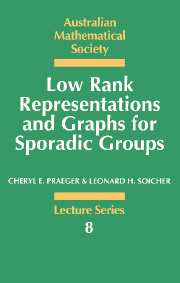5 - Summary of the Representations and Graphs
Published online by Cambridge University Press: 15 September 2009
Summary
In this chapter we give tables summarizing the transitive permutation representations and distance-regular generalized orbital graphs we have studied and classified in this book. In particular, Tables 5.1, 5.2, 5.3, and 5.4 list the primitive representations of respective ranks 2, 3, 4, and 5 of the sporadic almost simple groups, while Tables 5.5, 5.6, and 5.7 list the imprimitive representations of these groups for respective ranks 3, 4, and 5. These tables also give the number of distance-regular generalized orbital graphs for each of these representations. Finally, Table 5.8 gives a summary of the graphs of diameters 3 and 4 having a distance-transitive action by a sporadic almost simple group.
For each table of permutation representations, the column labelled ‘G’ gives the group being represented, the ‘case’ column gives the roman-numbered case for G in Chapter 4, where the representation is described in detail, the column labelled ‘H’ gives the point stabilizer, and ‘degree’ the degree of the representation. Notation of the form K[.2] for G and L[.2] for H denotes two representations of the same rank and degree: one of K.2 on the cosets of L.2, and the restriction of this representation to K on the cosets of L. In this situation there will be two entries in the ‘case’ column, corresponding respectively to K and K.2.
- Type
- Chapter
- Information
- Low Rank Representations and Graphs for Sporadic Groups , pp. 129 - 133Publisher: Cambridge University PressPrint publication year: 1996



